Was in a bird shop today buying some extra plastic cups for the birds. Normal chit chatting about the birds, economy and goverment ensues. These are difficult times and the topic of economic downturn is on everyones lips. Then came a topic that catches my attention. The owner told me that a customer complained to him that there is somebody in a certain place keeping lots of birds blatantly.
Oh my God, that can only be me :( as the place mentioned clicked hahahaha!
Now, as brief summary of Malaysian law on wildlife is strict to say the least. There are many common birds that are totally protected, some are not mentioned and a small handful that are allowed required a license to keep. The issuance of new licenses have been suspended for some time already. And the only way we can obtain one is to get a previous owner to transfer it to us albeit for a small payment.
Back to the story - the shop owner told him off and ask him to complain to the wildlife department if he is not happy. Now, I am not worried of him complaining as I have ample amount of licenses, maybe a few pieces extra (which presents another problem) but the sad thing to note is why are some people just so nosy. Its not as if I am torturing the birds under my care or something. In fact they are better off than being in some of their previous places (not all, but a majority). A case of sour grape? I can only guess. Which is why now my new ground rules is to avoid bringing people over to my house (hobbyists that is).
Lets consider wildlife conservation, bio-diversity and all that craps. Shouldn't it all start with nurturing a culture that promotes understanding of animals? What better way to understand animals than to keep them happy and healthy in a captive environment and learn how to breed them. I have actually grown to appreciate the many restrictions in Malaysia, in a way it is really keeping in check excesses by hobbyists. However, I would think the wildlife smugglers and exporters are more of a threat to the wildlife than the hobbyists like myself.
Friday, December 26, 2008
Thursday, December 25, 2008
Shama Tai Mong
Tai Mong refers to juvenile birds. Could be Shamas, Magies or even bulbuls. There has been many opinions given as to which stage of Shamas (age) makes a better songbird. Wild adults are said to posess their wild naturally learned repertoire of songs whereas baby birds would lack the capacity to do so as they have been removed from their wild environment. To compensate them from such disadvantage, often, a tutor bird is highly recommended.
For me, my preference often are skewed towards young juveniles for the mere fact that they tame down much easier than the adult birds. And often start singing after their first molt to adult plumage. Young juveniles, or often I prefer to call them the "flying babies" (vs those that still require hand feeding), have acquired their own style of songs.
This year, I kept two of such babies - one from Rompin which I kept for a friend and another from Grik which a friend decided to give up on. Both have developed nicely enough and started singing well before the adult plumage has fully grown. However I should be keeping them away from stressful competitive environment until after their second molt for best effect.
Rompin Tai Mong:
Grik Tai Mong:
For me, my preference often are skewed towards young juveniles for the mere fact that they tame down much easier than the adult birds. And often start singing after their first molt to adult plumage. Young juveniles, or often I prefer to call them the "flying babies" (vs those that still require hand feeding), have acquired their own style of songs.
This year, I kept two of such babies - one from Rompin which I kept for a friend and another from Grik which a friend decided to give up on. Both have developed nicely enough and started singing well before the adult plumage has fully grown. However I should be keeping them away from stressful competitive environment until after their second molt for best effect.
Rompin Tai Mong:
Grik Tai Mong:
Labels:
copsychus malabaricus,
tai mong,
white-rumped shama
Monday, December 22, 2008
Want not waste not
Bought 3 packets of insect food that doesn't look too fresh. Still usable but seems to deteriorate quite fast. Left a balance of 2 packets which I was thinking of feeding to the chicken. Then I thought why not start making bird food again. Since I am applying a theory of not letting the birds' system get too used to a single type of dry food, cooking my own food should accord this flexibility for me.
Didn't want to try something too complex, so a basic chicken feed base should suffice and it will sort of give a holiday from all those peanut feeds I have been relying on.
500g of chicken feed (Cargill Brand)
100g of dried insects
3 eggs
Method:
Sieved the chicken feed of the powdery feed to get a consistent larger pellets. Weigh the feed to get an exact 500g. Add 3 eggs and stir evenly. Then left to dry in oven at approximately 110 Celsius for 30 minutes. Fry in low fire in wok and work at getting the lumps to break down. Add 100g of dried insects (the not so fresh insect food), stir evenly and further roast at 125 Celsius in the oven for 15 minutes. The end result appears dried and palatable enough.
Not trusting my own food processing skills, I kept it in a fridge for storage until feeding time. So far so good......
Next batch, I may consider adding beef and probably egg shells.
Ready for the oven (minus the insects):

The dried insects:

Didn't want to try something too complex, so a basic chicken feed base should suffice and it will sort of give a holiday from all those peanut feeds I have been relying on.
500g of chicken feed (Cargill Brand)
100g of dried insects
3 eggs
Method:
Sieved the chicken feed of the powdery feed to get a consistent larger pellets. Weigh the feed to get an exact 500g. Add 3 eggs and stir evenly. Then left to dry in oven at approximately 110 Celsius for 30 minutes. Fry in low fire in wok and work at getting the lumps to break down. Add 100g of dried insects (the not so fresh insect food), stir evenly and further roast at 125 Celsius in the oven for 15 minutes. The end result appears dried and palatable enough.
Not trusting my own food processing skills, I kept it in a fridge for storage until feeding time. So far so good......
Next batch, I may consider adding beef and probably egg shells.
Ready for the oven (minus the insects):

The dried insects:

Saturday, December 20, 2008
Training a White-rumped Shama
Consider this - in the East Coast of Malaysia, the Red-whiskered Bulbul (Merbah Jambul) is competed at around eye level. Elsewhere, they are competed above head level, same as with the White-rumped Shama (Murai Batu) and Oriental White-eye (Mata Puteh). The Zebra Doves (Merbok) and Spotted Doves (Tekukur) are universally competed on top of poles 18 to 20 feet high. Hmmm...... how does all this come about? Maybe this all has to do with a bird's natural behaviour.
But hold on - in nature, the Red-whiskered Bulbul plays atop trees, so shouldn't they be hoisted up as well? Maybe it has more to do with commonly accepted avian culture (in Asia particularly) rather than anything. I do not know.
Well, since I have a pole for Zebra Doves, there is no harm in knowing how a caged Shama responds to higher altitude. I have tried it for a few days now on Apollo 6 and what I can say is that on the first day itself it took less than 5 seconds for him to start singing (which is more than I can say for my Zebra Doves). However, it should be noted that unlike Zebra Doves, Shamas do not tolerate heat too well, so I only start doing it about 6.30 to 7.00pm when there is no longer direct sunlight and leave him until dark about 8.00 to 9.00pm.
Below is Apollo 6 on day one at the pole.
But hold on - in nature, the Red-whiskered Bulbul plays atop trees, so shouldn't they be hoisted up as well? Maybe it has more to do with commonly accepted avian culture (in Asia particularly) rather than anything. I do not know.
Well, since I have a pole for Zebra Doves, there is no harm in knowing how a caged Shama responds to higher altitude. I have tried it for a few days now on Apollo 6 and what I can say is that on the first day itself it took less than 5 seconds for him to start singing (which is more than I can say for my Zebra Doves). However, it should be noted that unlike Zebra Doves, Shamas do not tolerate heat too well, so I only start doing it about 6.30 to 7.00pm when there is no longer direct sunlight and leave him until dark about 8.00 to 9.00pm.
Below is Apollo 6 on day one at the pole.
Labels:
apollo 6,
copsychus malabaricus,
white-rumped shama
Apollo 9 (White-rumped Shama)
This is a strange bird. Have been very patient with him. Molted once in a friend's home and molted again 2 months later in my home. Hmmmm....... he better keep his feathers longer this time round. Anyway, his form is rising up nicely now, a fella to watch out for. So far "chai" him at home only - will consider bringing him out soon or just let a friend keep him.
Labels:
apollo 9,
copsychus malabaricus,
white-rumped shama
Friday, December 19, 2008
Apollo 8 (White-rumped Shama)
Apollo 8 was obtained on 17th Dec 2008. Came with tail feathers of roughly 8". However he has the undesirable feature of having one longer and one shorter primary tail feather. During the previous molt, the tail feather is also uneven, hoping things may change in the subsequent molt, which may be some time yet as he has just finished his molt. He has quite a nice slim body and good song.
Decided on the name Apollo 8 due to being lazy to think up a name hahaha!
I had another Shama by the name of Apollo 8 which escaped last year. He could still be around, hopefully ;)
Decided on the name Apollo 8 due to being lazy to think up a name hahaha!
I had another Shama by the name of Apollo 8 which escaped last year. He could still be around, hopefully ;)
Labels:
apollo 8,
copsychus malabaricus,
white-rumped shama
Thursday, December 18, 2008
Apollo 6 (White-rumped Shama)
This is Apollo 6, last year's Tai Mong (juvenile). Still waiting for him to molt and change his second set of adult plumage. A few pin head feathers has appeared on his face, indicating that it should be very soon. I should be feeding him with lots of live food at the moment to facilitate his molt - hopefully I will come down to it soon hehehe! just me the procrastinator.
Originated from Endau, Johor, Apollo 6 is not a favoured Shama according to current trends due to his short and stiff tail. However, what he lacks in looks, he makes up with his willingness to sing anywhere, anytime. Therefore making a very reliable tutor bird for the other young ones. Him, being also considered a young Shama should be even better after his second molt.
Originated from Endau, Johor, Apollo 6 is not a favoured Shama according to current trends due to his short and stiff tail. However, what he lacks in looks, he makes up with his willingness to sing anywhere, anytime. Therefore making a very reliable tutor bird for the other young ones. Him, being also considered a young Shama should be even better after his second molt.
Labels:
apollo 6,
copsychus malabaricus,
white-rumped shama
Saturday, December 13, 2008
Blue-crowned Hanging Parrot (Serindit)
A fried was telling me that some Serindits have very good song, many "chap chee" or variety of tones. There is only one way to find out. Then a few days later he hand delivered to me a specimen for me to keep ;)
So far not too bad, but still waiting for him to show his full potential. Or is it bird specific? meaning some just don't cut it and only a few talented ones that makes the grade. Anyway, hoping that I got one of the "few".
So far not too bad, but still waiting for him to show his full potential. Or is it bird specific? meaning some just don't cut it and only a few talented ones that makes the grade. Anyway, hoping that I got one of the "few".
Local Merbok
The price of a bird is determined by a few factors, a rare species very often fetches a higher price than a common bird. However it is not always the case. A curious species to look at is the Merbok or Zebra Dove (a.k.a. Peaceful Dove), they are every where in South East Asia, a common bird found in the city, rural areas and even jungles.
These birds especially those that have been captive bred for their voice could fetch many thousands of Ringgit if certain criteria are met. The reasons must lie in the competitive nature of humans. And since everybody likes to win, the chase for a top competition bird naturally hikes up the price.
Often, the Merbok's wild cousin are overlooked just because their voice do not meet competition criteria (which is set by man anyway). After living with a wild local Merbok for a few months, I have grown fond of its voice. The natural wild call of the Doves - and it does varies from bird to bird but always distinctively "wild" song. The below can be considered a 2 step, with "angkatan" but no "kong" if I were to adopt competitive standards on him ;)
These birds especially those that have been captive bred for their voice could fetch many thousands of Ringgit if certain criteria are met. The reasons must lie in the competitive nature of humans. And since everybody likes to win, the chase for a top competition bird naturally hikes up the price.
Often, the Merbok's wild cousin are overlooked just because their voice do not meet competition criteria (which is set by man anyway). After living with a wild local Merbok for a few months, I have grown fond of its voice. The natural wild call of the Doves - and it does varies from bird to bird but always distinctively "wild" song. The below can be considered a 2 step, with "angkatan" but no "kong" if I were to adopt competitive standards on him ;)
Thursday, December 11, 2008
Asian Pied Starling
Took in a new bird on Monday. The Asian Pied Starling (Gracupica contra). A young bird just changing to adult plumage.
Kept mainly for the following purposes:
1) Good home guard as they will make noise upon seeing people approaching
2) Encourages other birds to sing (suppose to be quite hardworking)
3) Great to teach Hwa Mei to sing
4) Fun factor
5) They are songbirds of their own rights

Kept mainly for the following purposes:
1) Good home guard as they will make noise upon seeing people approaching
2) Encourages other birds to sing (suppose to be quite hardworking)
3) Great to teach Hwa Mei to sing
4) Fun factor
5) They are songbirds of their own rights

Tuesday, December 2, 2008
Serindit - Blue-crowned hanging parrot
Sunday, November 30, 2008
In memory of a fantastic pet bird
Today is a sad day for me. The bird that never fails to greet me when I wake up, when I came home, when I step out of the door has died a terrible death in the fangs of a cat. Seems like my verbal warning has not been heeded by them and a war has been declared.
This shrike which I didn't came to naming yet is the second casualty after the zebra dove yesterday.
Anyway, I wish to post a few photos of him as a tribute to him, a special bird.
Unfortunately I did not have time to take photos of him flying outside in the garden, from trees to trees.
You would be deeply missed, my dear friend :(
Rest in peace.... may you have better luck in your afterlife......



This shrike which I didn't came to naming yet is the second casualty after the zebra dove yesterday.
Anyway, I wish to post a few photos of him as a tribute to him, a special bird.
Unfortunately I did not have time to take photos of him flying outside in the garden, from trees to trees.
You would be deeply missed, my dear friend :(
Rest in peace.... may you have better luck in your afterlife......



Saturday, November 29, 2008
Sunday, November 23, 2008
Escaped Birds
I have birds escaped before. Often they come back if they have been kept for some months at least. Today a newly acquired Golden-fronted Leafbird escaped. Hope to be able to get him back. Later, the shrike also escaped. But being kept for 2 moltings already, it was apiece of cake getting him back. The only trick is to find him hehehe!
In about one hour plus time, I saw the shrike by the gate. Quickly caught a roach and drop into his cage and eventually he found his way in. Phew! one less homeless bird to worry about.
It sets me thinking though...... maybe time to give the shrike some free-flying time. Will work out how to go about it by Wednesday.
In about one hour plus time, I saw the shrike by the gate. Quickly caught a roach and drop into his cage and eventually he found his way in. Phew! one less homeless bird to worry about.
It sets me thinking though...... maybe time to give the shrike some free-flying time. Will work out how to go about it by Wednesday.
Saturday, November 22, 2008
D.I.Y. Puyuh cage
Friday, November 21, 2008
Trap for Quail
This trap is beautifully done. Crafted in Thailand.
Meant to trap "puyuh" or the quails. I am surprised that the carvings made it look like a grand door entrance to a house. For most birds, traps tend to be made to look natural or blend into the environment. These quail traps appears to the contrary.
Front view:

With the trap door held open, ready to be activated:

Finely woven back dome to house the "pikat":

Meant to trap "puyuh" or the quails. I am surprised that the carvings made it look like a grand door entrance to a house. For most birds, traps tend to be made to look natural or blend into the environment. These quail traps appears to the contrary.
Front view:

With the trap door held open, ready to be activated:

Finely woven back dome to house the "pikat":

Wild Mata Putehs
This wild Mata Puteh nearly killed my birds by eating too much and depriving the caged birds of food. Very difficult decision to make. Will try to make a feeding station for the wild Putehs.
Sunday, November 9, 2008
Zosterops in the Garden
2 friends dropped by today unannounced. Wanted to admire some of my collections. Must say that they are mesmerised by the number of species if not the number of birds. Seriously must make a mental note to reduce species and numbers. Anyway, noticed 4 Zosterops in the garden once I hang my own 2 birds out in the garden. Managed to capture them with my camera phone. They were not the least shy even with 3 adult humans observing them few feet away.

One of the reasons why I do not like "bird kakis" to visit unannounced. Lest they know the existence of this small family of Zosterops who frequent my place.
Highlighted below:


One of the reasons why I do not like "bird kakis" to visit unannounced. Lest they know the existence of this small family of Zosterops who frequent my place.
Highlighted below:

Sling Bag for Chicken
Sunday, October 26, 2008
An Adventure With Local Doves (7)
Local Zebra Dove in a "jebak" being trained as a "pikat".
Potential Spotted Dove for competition?
Potential Spotted Dove for competition?
Thursday, October 23, 2008
An Adventure With Local Doves (6)
Many learnings later, from the counting of scales on the feet of Merboks to many traps for wild Merboks, I am beginning to see why it has fascinated a portion of songbird hobbyists.
Bought myself some equipment which i intend to try out on my Merboks.
A better made jebak:


With additional hook:

With an extension to reach higher places:
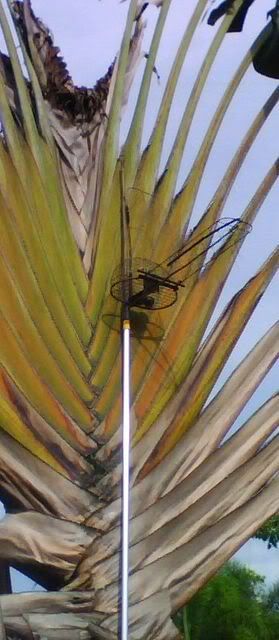
Bought myself some equipment which i intend to try out on my Merboks.
A better made jebak:


With additional hook:

With an extension to reach higher places:

Saturday, October 18, 2008
Trapping Merboks
Have been hearing many stories regarding the trappings of Merboks (Zebra Doves) from trappers. It appears these birds are not as easy as it seems. Especially when one is selective of the voice that he is looking for and the intelligence of these birds then becomes apparent.
It is not uncommon for a trapper to pursue a particular bird for more than a year at a time (with little or no success to show).
Trained my pikat at Bkt Serindit today together with a few guys who has been pursuing a particular bird for months. No success again today, but the persistance of these trappers are admirable ;)
It is not uncommon for a trapper to pursue a particular bird for more than a year at a time (with little or no success to show).
Trained my pikat at Bkt Serindit today together with a few guys who has been pursuing a particular bird for months. No success again today, but the persistance of these trappers are admirable ;)
Thursday, October 16, 2008
New C Merbok
New addition to the family. Yet to be named. Will compete him in the next comp for the fun factor and to know where he stands.
Also acquired a C female Merbok yesterday, thought of crossing her with a local Merbok to get a mix pikat hehehe! or maybe a B male just for the fun of breeding ;)
Also acquired a C female Merbok yesterday, thought of crossing her with a local Merbok to get a mix pikat hehehe! or maybe a B male just for the fun of breeding ;)
An Adventure With Local Doves (5)
Spotted a wild Spotted Dove. One "guk" bird. Louder voice is my pikat. Softer voice is the Tekukur on the roof. Nothing happened - just singing only. I made it a point not to own any "racik".
Zeus (4)
Today (15th Oct), Zeus's cage fell down and a few sticks was broken. Luckily Zeus did not injure himself. My mistake - I didn't see that the cage is hooked properly. Note to self - don't be too confident ;)
A video of Zeus with Apollo 9's voice in the background. Need to compete Zeus in K.L. to see how he performs.
A video of Zeus with Apollo 9's voice in the background. Need to compete Zeus in K.L. to see how he performs.
Sunday, October 12, 2008
An Adventure With Local Doves (4)

Venue: Masjid Tanah
Date: 11th Oct 2008
Birds: Merbok & Tekukur
Nice outing for a Raya visit cum bird training session ;)
A pair of wild Merboks came near but did not step on the "jebak".
Was there with Chong & Freddie.
Took back one C Merbok. Suppose to be top 20 bird. Hope can pakai hehehe!
Video my my Tekukur taken a couple of days earlier:
Sunday, October 5, 2008
Zeus (3)
Zeus today performed beyond expectation at the competition in Bt Pahat. Now, why would I say that its beyond expectation? I actually was hoping for some consolation prizes for the effort but from round one, words was abuzz about the no. 30 Shama (Zeus) hehehe!
This was what was reported to me by a friend:
1) One of the judges was mumbling something about no.30
2) Someone said that no.30 is from Muar
3) Various other comments
That was when we realised Zeus has become a favourite to win on that day. My friend Hock told me top 5 sure got one hahaha!
So it was a pleasant surprised.
Back to the question - why do I think that Zeus is not up to mark? Maybe because of the way he behaved at the "chai" area in Melaka. Or maybe he does not have the quality I would like a top Shama to have. He was an average Shama to me.
However on the competition day, I would think that he turned the tables due to his enthusiasm. Displaying and singing like a Shama on steroid for the 1st round at least. That is where he clinched his advantage with a leading 0.5 points above the closest Shama. He toned down on round 3 and 4, but sufficient to match other top birds. I was not there on round 2 because we went out to have breakfast. I think that was how he managed to win against other "better" birds.
It also helps that the cloth cover was removed at the last minute as I am aware that Zeus always does his best in the first half hour or so. If the cloth was removed too early, he may have run out of steam before the judge move to his cage.
This is him on the first round. Difficult to video him as he was quite inside the ring and blocked by other cages.
What was established on that day:
1) Timing is important
2) You do not need a beautiful cage to win (mine was a cheap 2nd hand RM60 cage hehe!)
3) At least judges, judged birds on their own merits for the day - I am an unknown player but still can get top prize ;)
4) An element of luck - the slight breeze blowing that day makes Zeus's tail appears to be flicked higher than normal ;)
5) Be Prepared: Zeus was fed 6 crickets in the morning for extra energy. 2 of which was enriched by being injected with multivitamins
This was what was reported to me by a friend:
1) One of the judges was mumbling something about no.30
2) Someone said that no.30 is from Muar
3) Various other comments
That was when we realised Zeus has become a favourite to win on that day. My friend Hock told me top 5 sure got one hahaha!
So it was a pleasant surprised.
Back to the question - why do I think that Zeus is not up to mark? Maybe because of the way he behaved at the "chai" area in Melaka. Or maybe he does not have the quality I would like a top Shama to have. He was an average Shama to me.
However on the competition day, I would think that he turned the tables due to his enthusiasm. Displaying and singing like a Shama on steroid for the 1st round at least. That is where he clinched his advantage with a leading 0.5 points above the closest Shama. He toned down on round 3 and 4, but sufficient to match other top birds. I was not there on round 2 because we went out to have breakfast. I think that was how he managed to win against other "better" birds.
It also helps that the cloth cover was removed at the last minute as I am aware that Zeus always does his best in the first half hour or so. If the cloth was removed too early, he may have run out of steam before the judge move to his cage.
This is him on the first round. Difficult to video him as he was quite inside the ring and blocked by other cages.
What was established on that day:
1) Timing is important
2) You do not need a beautiful cage to win (mine was a cheap 2nd hand RM60 cage hehe!)
3) At least judges, judged birds on their own merits for the day - I am an unknown player but still can get top prize ;)
4) An element of luck - the slight breeze blowing that day makes Zeus's tail appears to be flicked higher than normal ;)
5) Be Prepared: Zeus was fed 6 crickets in the morning for extra energy. 2 of which was enriched by being injected with multivitamins
Batu Pahat Competition
It has been an eventful day - bird related that is.
Of the 7 persons who may be going to Bt. Pahat from Melaka, only 3 of us made it. I brought along a Shama, Mata Puteh and Jambul whereas my friend Hock just brought one Shama and his friend Tan. We had a light breakfast first near Tan's place before beginning our journey around 7.30am. It doesn't help that my son woke up at 4.30am and kept me up whole morning. But it did give me more time to plan and prepare the birds though.
The Mata Puteh section (22 contestants):

The Magpie Robin section (39 contestants):
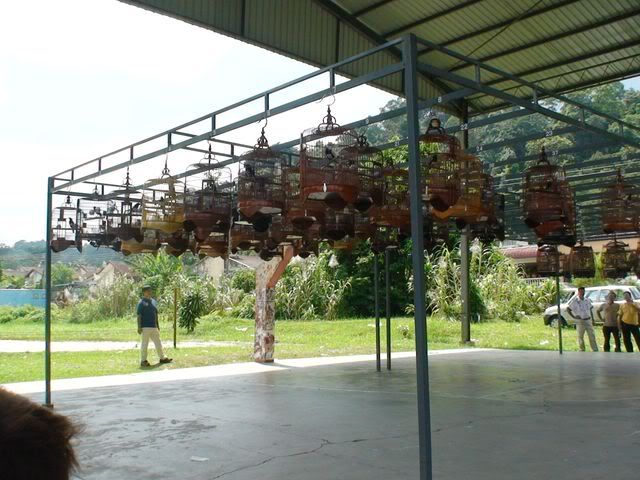
The Merbah Jambul section (29 contestants):
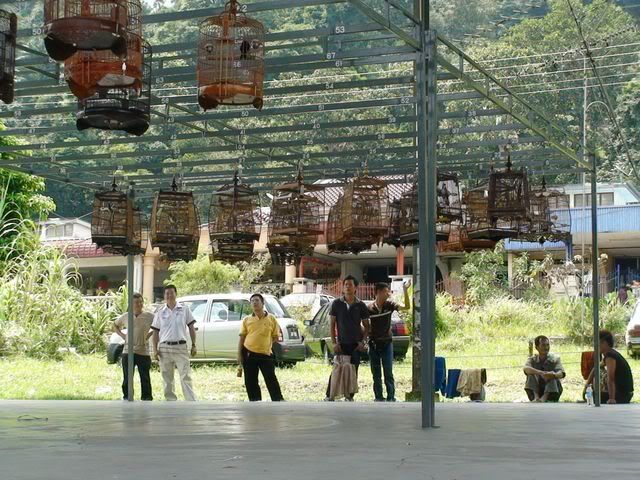
The White-rumped Shama section (42 contestants):
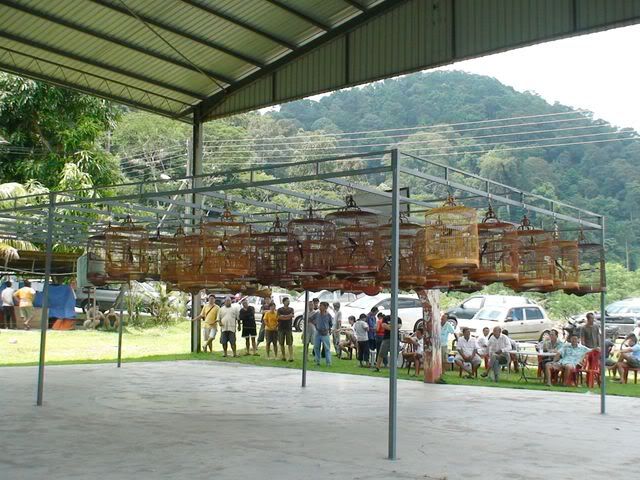
My Merbah Jambul did not win any prize but got some good comments. Need to "chai" more often. But where in Melaka got people keep Jambul? Only a handful that I know of.
Same case with my Mata Puteh, seen busy preening himself. Only really sing when we were about to go home hahahaha! Next time he is staying home.
My White-rumped Shama named Zeus was a different story though. I never expect him to clinch the no. 1 position but he just did. Must tell the story of Zeus in a different post ;)
Zeus's result (bird no. 30):
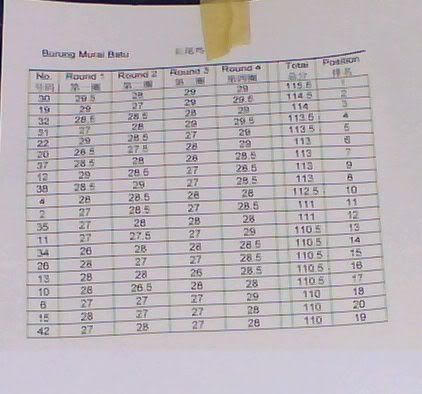
Of the 7 persons who may be going to Bt. Pahat from Melaka, only 3 of us made it. I brought along a Shama, Mata Puteh and Jambul whereas my friend Hock just brought one Shama and his friend Tan. We had a light breakfast first near Tan's place before beginning our journey around 7.30am. It doesn't help that my son woke up at 4.30am and kept me up whole morning. But it did give me more time to plan and prepare the birds though.
The Mata Puteh section (22 contestants):

The Magpie Robin section (39 contestants):

The Merbah Jambul section (29 contestants):

The White-rumped Shama section (42 contestants):

My Merbah Jambul did not win any prize but got some good comments. Need to "chai" more often. But where in Melaka got people keep Jambul? Only a handful that I know of.
Same case with my Mata Puteh, seen busy preening himself. Only really sing when we were about to go home hahahaha! Next time he is staying home.
My White-rumped Shama named Zeus was a different story though. I never expect him to clinch the no. 1 position but he just did. Must tell the story of Zeus in a different post ;)
Zeus's result (bird no. 30):

Saturday, October 4, 2008
An Adventure with Local Doves (3)
This morning was a bit disappointing for my Tekukur Pikat. Brought him out to the Merbok field but he refused to sing. Aiya! at hime so fierce ;)
Anyway to compensate for the day, 2 things happen.
First my Merbok Pikat (Lets call him Si Gelang Biru) sang inside his jebak for the first time. Sang quite long. Below is a pic of him hang up for training:

Then this fella (Tekukur - Spotted Dove) that was taken from a friend's aviary decided to sing as well:
Anyway to compensate for the day, 2 things happen.
First my Merbok Pikat (Lets call him Si Gelang Biru) sang inside his jebak for the first time. Sang quite long. Below is a pic of him hang up for training:

Then this fella (Tekukur - Spotted Dove) that was taken from a friend's aviary decided to sing as well:
Thursday, October 2, 2008
An Adventure with Local Doves (2)
The below is a video of my new pet dove. Tekukur in Malay language. Took back yesterday from a friend and reach home at night. So, he probably sleep well as already singing softly in the morning. Will try to take a video of his loud song when he "tekan". A little droopy left wing due to an old injury probably. He will provide lots of fun on field outings I presume ;)
Besides him, another Tekukur was also given, forcefully, I might add hahahaha! Anyway, I will wait for him to sing before training him to sing in the "jebak" below. Side by side, a comparison in size of a Merbok's jebak with a Tekukur's.

Besides him, another Tekukur was also given, forcefully, I might add hahahaha! Anyway, I will wait for him to sing before training him to sing in the "jebak" below. Side by side, a comparison in size of a Merbok's jebak with a Tekukur's.

Wednesday, October 1, 2008
An Adventure with Local Doves
Ok! how to start this?......
hmmmm! a friend dropped by on 29th Sept and pass me the following:
1 Thai Merbok, 2 Local Merbok, 1 Jebak
Local Merboks are supposed to be trained as a "pikat" to lure wild birds to the trap.
Candidate no.1 :
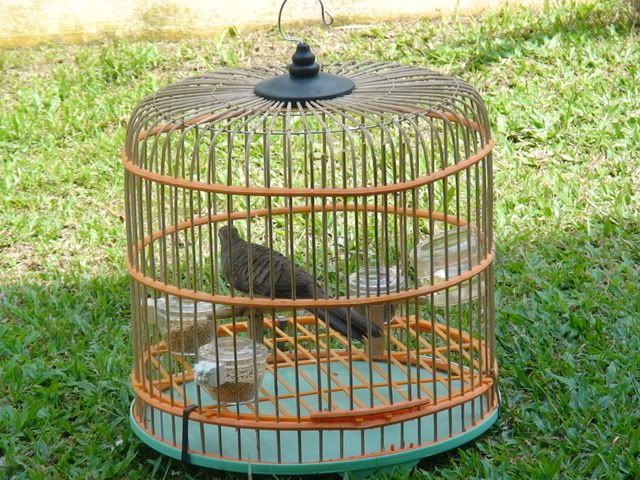
Candidate no.1 :
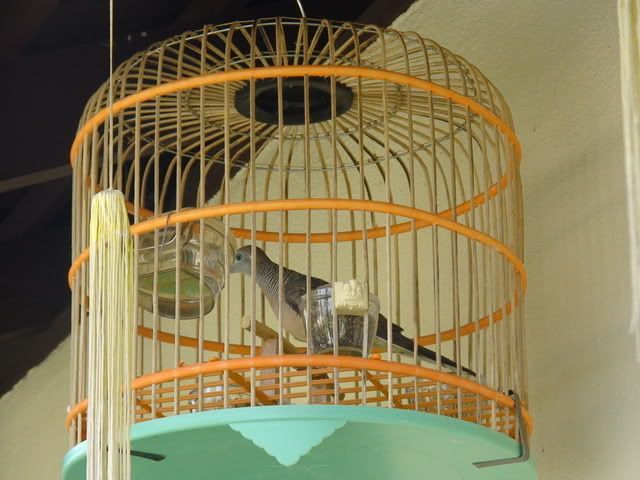
The Trap (Jebak):
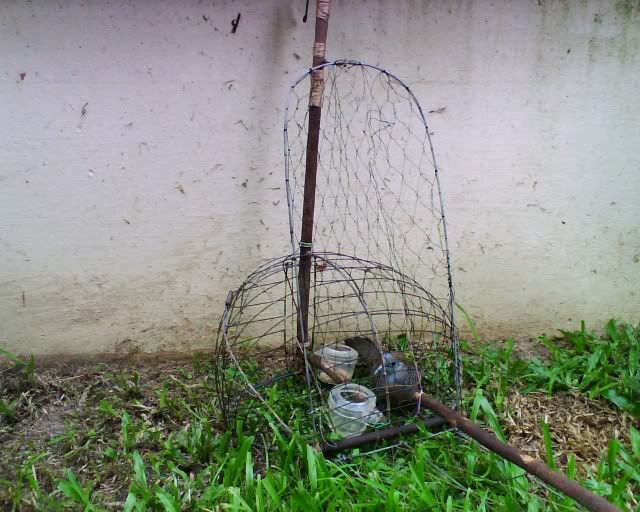
However unfortunately, one of the pikat was attacked by a cat while I was away today.
No critical injuries. Feathers on the head ruffled up a bit and some blood stain was seen. Hope he is alright. Transfered him to a normal cage.
Today he gave me another 2 Terkukur and a Jebak. Scratching my head how to house all of them. Will see how the Terkukur sing in my house tomorrow.
hmmmm! a friend dropped by on 29th Sept and pass me the following:
1 Thai Merbok, 2 Local Merbok, 1 Jebak
Local Merboks are supposed to be trained as a "pikat" to lure wild birds to the trap.
Candidate no.1 :

Candidate no.1 :

The Trap (Jebak):

However unfortunately, one of the pikat was attacked by a cat while I was away today.
No critical injuries. Feathers on the head ruffled up a bit and some blood stain was seen. Hope he is alright. Transfered him to a normal cage.
Today he gave me another 2 Terkukur and a Jebak. Scratching my head how to house all of them. Will see how the Terkukur sing in my house tomorrow.
Monday, September 29, 2008
Zeus (2)
New Addition - Merbok
Oh my God! got a gift of 3 merboks from a friend. How eh? to keep them? Went out to buy 2 cheap cages and 8 plastic cups. Lucky I have a spare Magpie cage.
Below is the Thai Merbok at day one after arrival in a paper bag, bath, fed 5 green beans and sunned:
Already have his growling sound (derak):
Pikat candidate 1:

Pikat candidate 2:

Below is the Thai Merbok at day one after arrival in a paper bag, bath, fed 5 green beans and sunned:
Already have his growling sound (derak):
Pikat candidate 1:

Pikat candidate 2:

Saturday, September 27, 2008
History and Nature of Bird Singing Contest in Singapore -By Mr. John Yim
History and Nature of Bird Singing Contest in Singapore
By Mr. John Yim
After World War II
A decade after the second World War, in September 1945, bird lovers in Singapore begin to own birds, i.e. in the mid-1950s. At that time only birds like the Magpies, canaries, Budgerigars, Java Sparrows, commonly called the Fortune Telling birds, Zebra Doves (Merboks) were kept. Also owned by a few bird lovers were Shamas, White Eyes, Bulbuls and China be-spectacled thrushes. Lack of the correct knowledge in keeping and in obtaining the proper type of feeds prevent many others in keeping them.
I started then to keep half a dozen Canaries and about 10 nestling and wild Magpies.
Singapore Cage Birds Society
Around 1956 families of the British Armed Forces in Singapore who were fond of pets kept a few birds and they usually bring along their pet birds to their friends’ quarters to compare notes. The main topic was the display of their birds to show to others. Discussions on how to improve their health, colour of plumage, tameness and postures, but not so much on their songs.
Gradually a Society called the Singapore Cage Birds Society was born. This Society met once a month at various places of members. On the invitationsby a few committee members like Mr Fraser Bryner (?), Miss Stevens, Mrs Mitchell, and some others whose names I am unable to recollect, I used to attend their bird displays or shows on a few occasions. Most of the birds on displays or shows were not necessary be songsters. Birds like Budgerigars, Canaries, Java Sparrows, Magpie Robins head the list followed by a few colourful Lorikeets, even a Hanging Parakeet and a Lesser Yellow Crested Cockatoo were on display. Someone also brought along a Guinea-pig on one occasion. It was very interesting to observe the age group bringing their birds. Some tender age children carried them in light wooden cages and whereas elderly ladies pushing theirs in prams.
More Birds in 1960s – Places of Meetings/Displays
In 1960 more variety of birds came in at the 3 birdshops in Rochore Road – Ms Lim Chye Huat, Eang Siang and Ann Soon Hong.
Many bird lovers began keeping birds as a hobby. In the heart of Chinatown, Ann Siang Hill Coffee Shop became a hive of bird activities on Sunday mornings and in the evenings on weekdays. No doubt bird lovers have already gathered there with their pet birds two years earlier, there were quite a number of birds could be viewed but not so many were keen in competing their birds for songs, but rather on betting with bird fights. Three types were common – Wah-Bees, White-eyes and Magpies, the later for fighting purposes.
Later when these fights became illegal, birds were in there for challenging of their songs and also for acquiring more variety of songs and tunes from other birds. Bettings were also carried on their length of singing.
To many their attitude changed. Letting their birds fight and bleed seemed cruel. A new sense of feeling prompted these bird lovers. Birds with loud songs and a good variety of songs fetch high prices. They began bringing in their birds for training. The logic was that a concentration of caged songsters exposed in a limited area will cause their own birds to create another tune and simultaneously their own birds have many chances of picking up different tune from others. This is true till the presentmoment at the various bird singing contest and meeting places of bird lovers. Birds exposed in this way also gather stamina and acquire display.
Venues elsewhere
Of course elsewhere bird lovers held such-like meetings and displays, like the 3 birdshops in Rochore Road, at Verandahs of Pork-sellers along South Bridge Road, Petain Road Car Park, Alkaff Garden-cum-lake, the large compound of the Church of England, Mt. Rosie, Mt. Faber and also at Central Park.
In the various venues different kinds of birds are being displayed according to the types of fruits and flower trees and the surrounding shrubs. Not surprisingly wild birds of the same specie did appear to challenge in their songs. Anyway, through my experience a good number of White-eyes did appear in the grounds of the Church of England: Bulbuls and Shamas in Mt. Rosie and Shamas, Bulbuls and Wah-Bees in Central Park.
Bird Lovers Meetings/Displays:
Not long after at these places of meetings and displays bird-lovers and their friends used to gather and have bettings to see which bird has the most varieties, stamina and play. They were judged by their friends and sometimes with one or two outsiders to help select the best bird. Usually the more people who were in favour of one particular bird, that bird is declared the winner. The losers combine to pay for the winner’s of winners’ lunches and drinks. This would carry on week after week on Sunday mornings with a larger group each time.
Birth of Club Burung Singapura:
By 1963, we saw the birth of the Club Burong Singapura headed by Dr. Tay Kah Seng who himself was a keen lover of birds and animals. The first Bird Singing Contest was held the following year at a school compound. All the four types of birds – Thrushes, Shamas, Bulbuls and White-eyes competed. Judges were difficult to find. Old timers of bird-keeping who have either kept one specie or all the four species at one time or other, the later were only a few, were called to assist in the judging.
Judging posed no problem as there were not so many birds to judge than at the present moment. Moreover, half of those competing were either fighting shy, loose face, or due to fright and only manage to remain still and lack form in their cages.
Judges were instructed to give points or marks on:-
a) Loudness
b) Variety
c) Stamina
d) Posture
At that time only 2 or 3 judges were required to view and select the birds in each section. No doubt there was slight confusion in the beginning, as in most cases to other events too, being first-time in bird competition, but eventually all went well and ended up well. Prize winners were happy to bring home their trophies.
Word went round after this competition and gradually the momentum of Bird Singing Competition caught up. By 1964 there were more bird owners and more bird lovers have keen interest in owning many and different species at one time in order to prepare for future competitions..
The following year 3 to 4 competitions were organized by the ClubBurung Singapura and Community Centres. A few years following this period more competitions were organized by various Community Centres in a year. By 1970 there were at least 10 competitions in a year, but 5 years later as many as a dozen were organized. I remembered there were 14 such competitions in 1976 organised by the various Community Centres. Mind you, in one competition alone there were over 760 birds of the 4 popular species participated. Comparing this figure with the mid-60s there were less than 200 birds in all..
Comparisons:
Birds of the 1960’s, 70’s and 80’s were different by way of their songs, structure and stamina. The present day birds have all their qualities. Bird lovers have gathered much knowledge and are very well conversant with different species, and the considerable time spent and care given to their birds. In other words they treasure them much more than their own children. I do not mean all of them.
Those in the 1960’s were not well built, but plumpy, songs and stamina were limited and postures not stylish at all. The present birds have all the following qualities: loudness, stamina, variety, posture and or physic, display and fierceness.
Take for instance the Thrushes. They are bigger, stylish and with louder songs and plentiful of variety.
The Shamas have longer built bodies and with longer tails and very fine display.
The Bulbuls having longer and well shaped crests. On the other hand the White-eyes are definitely much longer in their body structures and having bigger white-ringed eyes. Their song drag on much longer and louder.
Overall I can see the Bird Singing Contest in Singapore will go a long way because of its popularity, cheap in the entrance fees in competing, various types of birds are easily manageable, knowledge of keeping them is a household word and last but not least judges have abundance of experience and they are strictly keeping on the fair and just judging.
John Yim
12th August 1983
Note: This article has been reproduced here with Mr. John Yim's consent
By Mr. John Yim
After World War II
A decade after the second World War, in September 1945, bird lovers in Singapore begin to own birds, i.e. in the mid-1950s. At that time only birds like the Magpies, canaries, Budgerigars, Java Sparrows, commonly called the Fortune Telling birds, Zebra Doves (Merboks) were kept. Also owned by a few bird lovers were Shamas, White Eyes, Bulbuls and China be-spectacled thrushes. Lack of the correct knowledge in keeping and in obtaining the proper type of feeds prevent many others in keeping them.
I started then to keep half a dozen Canaries and about 10 nestling and wild Magpies.
Singapore Cage Birds Society
Around 1956 families of the British Armed Forces in Singapore who were fond of pets kept a few birds and they usually bring along their pet birds to their friends’ quarters to compare notes. The main topic was the display of their birds to show to others. Discussions on how to improve their health, colour of plumage, tameness and postures, but not so much on their songs.
Gradually a Society called the Singapore Cage Birds Society was born. This Society met once a month at various places of members. On the invitationsby a few committee members like Mr Fraser Bryner (?), Miss Stevens, Mrs Mitchell, and some others whose names I am unable to recollect, I used to attend their bird displays or shows on a few occasions. Most of the birds on displays or shows were not necessary be songsters. Birds like Budgerigars, Canaries, Java Sparrows, Magpie Robins head the list followed by a few colourful Lorikeets, even a Hanging Parakeet and a Lesser Yellow Crested Cockatoo were on display. Someone also brought along a Guinea-pig on one occasion. It was very interesting to observe the age group bringing their birds. Some tender age children carried them in light wooden cages and whereas elderly ladies pushing theirs in prams.
More Birds in 1960s – Places of Meetings/Displays
In 1960 more variety of birds came in at the 3 birdshops in Rochore Road – Ms Lim Chye Huat, Eang Siang and Ann Soon Hong.
Many bird lovers began keeping birds as a hobby. In the heart of Chinatown, Ann Siang Hill Coffee Shop became a hive of bird activities on Sunday mornings and in the evenings on weekdays. No doubt bird lovers have already gathered there with their pet birds two years earlier, there were quite a number of birds could be viewed but not so many were keen in competing their birds for songs, but rather on betting with bird fights. Three types were common – Wah-Bees, White-eyes and Magpies, the later for fighting purposes.
Later when these fights became illegal, birds were in there for challenging of their songs and also for acquiring more variety of songs and tunes from other birds. Bettings were also carried on their length of singing.
To many their attitude changed. Letting their birds fight and bleed seemed cruel. A new sense of feeling prompted these bird lovers. Birds with loud songs and a good variety of songs fetch high prices. They began bringing in their birds for training. The logic was that a concentration of caged songsters exposed in a limited area will cause their own birds to create another tune and simultaneously their own birds have many chances of picking up different tune from others. This is true till the presentmoment at the various bird singing contest and meeting places of bird lovers. Birds exposed in this way also gather stamina and acquire display.
Venues elsewhere
Of course elsewhere bird lovers held such-like meetings and displays, like the 3 birdshops in Rochore Road, at Verandahs of Pork-sellers along South Bridge Road, Petain Road Car Park, Alkaff Garden-cum-lake, the large compound of the Church of England, Mt. Rosie, Mt. Faber and also at Central Park.
In the various venues different kinds of birds are being displayed according to the types of fruits and flower trees and the surrounding shrubs. Not surprisingly wild birds of the same specie did appear to challenge in their songs. Anyway, through my experience a good number of White-eyes did appear in the grounds of the Church of England: Bulbuls and Shamas in Mt. Rosie and Shamas, Bulbuls and Wah-Bees in Central Park.
Bird Lovers Meetings/Displays:
Not long after at these places of meetings and displays bird-lovers and their friends used to gather and have bettings to see which bird has the most varieties, stamina and play. They were judged by their friends and sometimes with one or two outsiders to help select the best bird. Usually the more people who were in favour of one particular bird, that bird is declared the winner. The losers combine to pay for the winner’s of winners’ lunches and drinks. This would carry on week after week on Sunday mornings with a larger group each time.
Birth of Club Burung Singapura:
By 1963, we saw the birth of the Club Burong Singapura headed by Dr. Tay Kah Seng who himself was a keen lover of birds and animals. The first Bird Singing Contest was held the following year at a school compound. All the four types of birds – Thrushes, Shamas, Bulbuls and White-eyes competed. Judges were difficult to find. Old timers of bird-keeping who have either kept one specie or all the four species at one time or other, the later were only a few, were called to assist in the judging.
Judging posed no problem as there were not so many birds to judge than at the present moment. Moreover, half of those competing were either fighting shy, loose face, or due to fright and only manage to remain still and lack form in their cages.
Judges were instructed to give points or marks on:-
a) Loudness
b) Variety
c) Stamina
d) Posture
At that time only 2 or 3 judges were required to view and select the birds in each section. No doubt there was slight confusion in the beginning, as in most cases to other events too, being first-time in bird competition, but eventually all went well and ended up well. Prize winners were happy to bring home their trophies.
Word went round after this competition and gradually the momentum of Bird Singing Competition caught up. By 1964 there were more bird owners and more bird lovers have keen interest in owning many and different species at one time in order to prepare for future competitions..
The following year 3 to 4 competitions were organized by the ClubBurung Singapura and Community Centres. A few years following this period more competitions were organized by various Community Centres in a year. By 1970 there were at least 10 competitions in a year, but 5 years later as many as a dozen were organized. I remembered there were 14 such competitions in 1976 organised by the various Community Centres. Mind you, in one competition alone there were over 760 birds of the 4 popular species participated. Comparing this figure with the mid-60s there were less than 200 birds in all..
Comparisons:
Birds of the 1960’s, 70’s and 80’s were different by way of their songs, structure and stamina. The present day birds have all their qualities. Bird lovers have gathered much knowledge and are very well conversant with different species, and the considerable time spent and care given to their birds. In other words they treasure them much more than their own children. I do not mean all of them.
Those in the 1960’s were not well built, but plumpy, songs and stamina were limited and postures not stylish at all. The present birds have all the following qualities: loudness, stamina, variety, posture and or physic, display and fierceness.
Take for instance the Thrushes. They are bigger, stylish and with louder songs and plentiful of variety.
The Shamas have longer built bodies and with longer tails and very fine display.
The Bulbuls having longer and well shaped crests. On the other hand the White-eyes are definitely much longer in their body structures and having bigger white-ringed eyes. Their song drag on much longer and louder.
Overall I can see the Bird Singing Contest in Singapore will go a long way because of its popularity, cheap in the entrance fees in competing, various types of birds are easily manageable, knowledge of keeping them is a household word and last but not least judges have abundance of experience and they are strictly keeping on the fair and just judging.
John Yim
12th August 1983
Note: This article has been reproduced here with Mr. John Yim's consent
Sunday, September 21, 2008
Shama Meet - Melaka (2)
Today: 21st Sept 2008
No. of Shamas = 5
Mata Puteh = 4
Merbah Jambul = 1
Terkukur Pikat = 2
Merbok Pikat = 1
It is a natural extension to a "chai" place - new member, new things to do. One new Shama player came although number of birds reduced due to 2 members being busy (1 went to Genting, 1 went to K.L.). Brought my Jambul out today and ask a friend to get me a Terkukur to train as pikat just to join in the fun. I have no intention to go catch the wild terkukurs. Just want to train until I get a bird that sings when pegged to the ground. Today is a first outing for Zeus (Shama) to this place. He performed well initially but lost steam along the way. Maybe not in top condition yet. Will need to evaluate whether he is ready for the Batu Pahat comp on 5th Oct. Might have to leave him behind.
No. of Shamas = 5
Mata Puteh = 4
Merbah Jambul = 1
Terkukur Pikat = 2
Merbok Pikat = 1
It is a natural extension to a "chai" place - new member, new things to do. One new Shama player came although number of birds reduced due to 2 members being busy (1 went to Genting, 1 went to K.L.). Brought my Jambul out today and ask a friend to get me a Terkukur to train as pikat just to join in the fun. I have no intention to go catch the wild terkukurs. Just want to train until I get a bird that sings when pegged to the ground. Today is a first outing for Zeus (Shama) to this place. He performed well initially but lost steam along the way. Maybe not in top condition yet. Will need to evaluate whether he is ready for the Batu Pahat comp on 5th Oct. Might have to leave him behind.
Saturday, September 20, 2008
Apollo 9
Today found 2 primary tail feathers of Apollo 9 on the floor of the aviary. He must have molted them at the most 1 day apart. 1 measured at 8" and another at 8.2" The task now is to see whether with enough live food, it can grow back to his former 9" or longer. Last molt was just 3 or 4 months ago. very strange.


Monday, September 15, 2008
Development of SR
SR has become more hardworking at home. Am happy with his development. However still a bit shy at the Merbok field (only 2nd day, so can't blame him). Hope one day Suara Rakyat would "tekan" so that his voice would reveberate in the field hehehe! wishful thinking ;)
Sunday, September 14, 2008
Shama meet - Melaka (1)
Today: 14th Sept 2008
No. of Shamas = 7
Mata Puteh = 1
This appears to be a very popular tree. We started by having the Shamas spaced out and they were calling beautifully. Nothing beats a Shama's song in natural open spaces in my opinion. And to have a number of them singing to each other in a spaced out setting is just wonderful. Towards the end of the session, we regroup ,mainly under this tree:
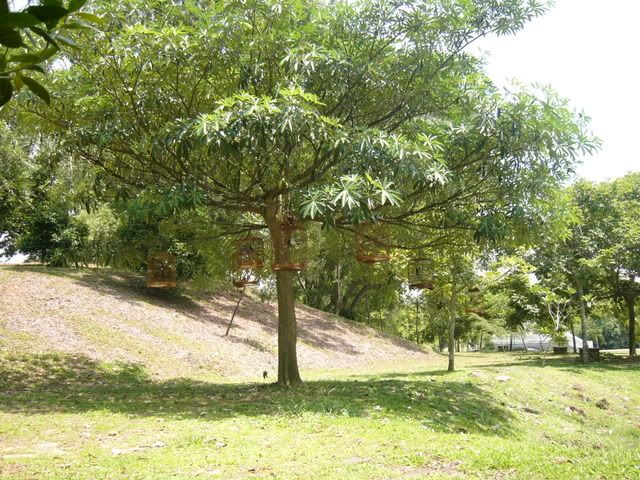
A close-up:
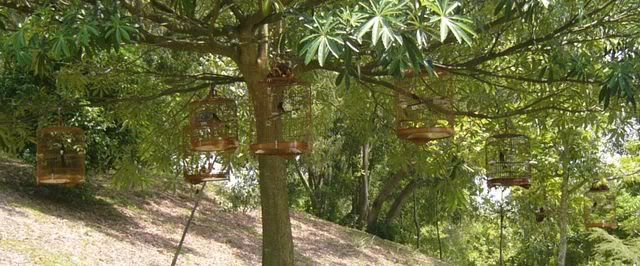
My Merbok which I have decided to name "Suara Rakyat" or "SR" due to many reasons. Mainly being a "permainan rakyat" which is a traditional sports of the people, I suppose, SR translates into the owner's hope that his Merbok's voice would one day be heard by all ;)
Not to mention the current political scenario, and the hope that "rakyat" would be heard. hehehe! anyway, this is suppose to be a fun thing. Lets leave the serious stuff behind ;)
Here he is raised to full pole vs half yesterday:
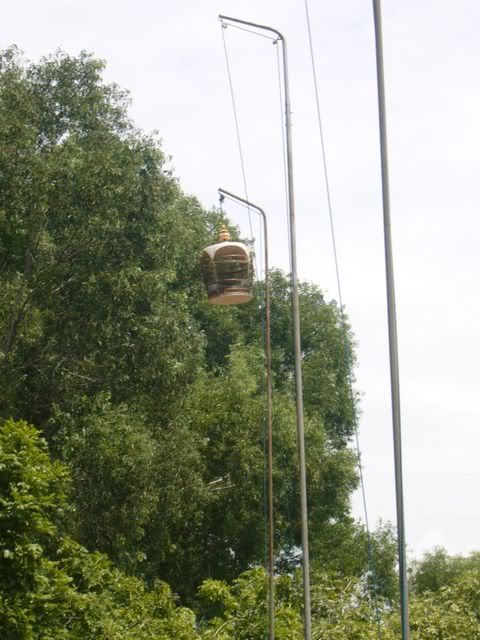
Still placed at the fringe of the field away from the fiercer birds:

Was introduced to this "jarum emas" today. Suppose to be good for the libido, against worms...... will try it on my Green Singing Finch later.

No. of Shamas = 7
Mata Puteh = 1
This appears to be a very popular tree. We started by having the Shamas spaced out and they were calling beautifully. Nothing beats a Shama's song in natural open spaces in my opinion. And to have a number of them singing to each other in a spaced out setting is just wonderful. Towards the end of the session, we regroup ,mainly under this tree:

A close-up:

My Merbok which I have decided to name "Suara Rakyat" or "SR" due to many reasons. Mainly being a "permainan rakyat" which is a traditional sports of the people, I suppose, SR translates into the owner's hope that his Merbok's voice would one day be heard by all ;)
Not to mention the current political scenario, and the hope that "rakyat" would be heard. hehehe! anyway, this is suppose to be a fun thing. Lets leave the serious stuff behind ;)
Here he is raised to full pole vs half yesterday:

Still placed at the fringe of the field away from the fiercer birds:

Was introduced to this "jarum emas" today. Suppose to be good for the libido, against worms...... will try it on my Green Singing Finch later.

Saturday, September 13, 2008
Pied Bushchat
Chai Merbok
Today is the first time I go and "chai" merbok.
7 month old merbok that I obtained from Yusuf, a friend. B class.
Hang him at half pole and at the fringe of the field as advised by some old timers there. Tan, a fellow hobbyist said that he heard the merbok called once and was impressed. If it could maintain its voice, then I probably could compete him later on. As for me, I didn't actually hear him because I was busy chit chatting, observing other people's merboks and went off for breakfast. Was there about 10am and went back by 12.30pm.
Well, the purpose wasn't that actually (competing merboks), just want to blend in with their crowd...... then the Shamas could make a smoother transition to the adjoining field hehehe! Never good to isolate ourselves. We must move with the bigger crowd ;)
However something seems to be wrong with my camera phone. Pictures all turn out very dark. Must have been all the mishandling it is receiving. Have to brighten it with with some software.
This is my new pet - circled in red:
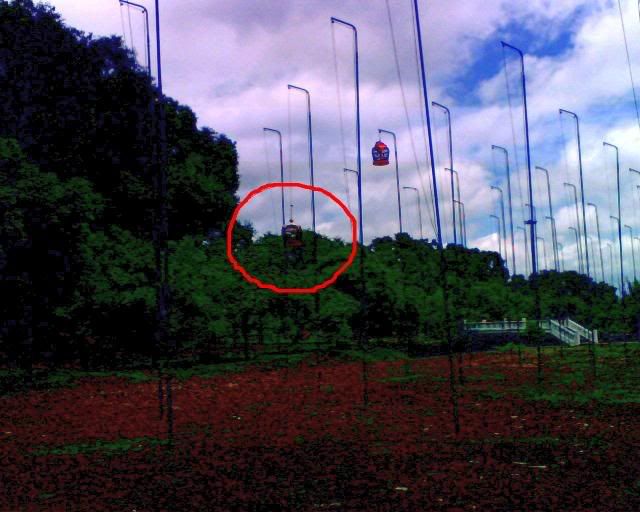
Scene at the other end of the field:
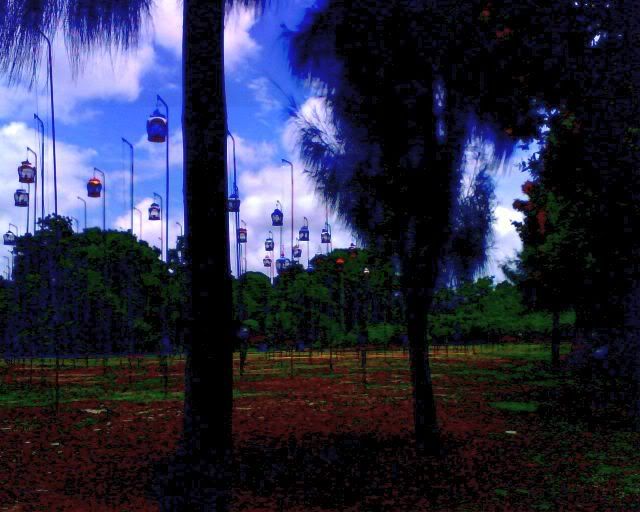
7 month old merbok that I obtained from Yusuf, a friend. B class.
Hang him at half pole and at the fringe of the field as advised by some old timers there. Tan, a fellow hobbyist said that he heard the merbok called once and was impressed. If it could maintain its voice, then I probably could compete him later on. As for me, I didn't actually hear him because I was busy chit chatting, observing other people's merboks and went off for breakfast. Was there about 10am and went back by 12.30pm.
Well, the purpose wasn't that actually (competing merboks), just want to blend in with their crowd...... then the Shamas could make a smoother transition to the adjoining field hehehe! Never good to isolate ourselves. We must move with the bigger crowd ;)
However something seems to be wrong with my camera phone. Pictures all turn out very dark. Must have been all the mishandling it is receiving. Have to brighten it with with some software.
This is my new pet - circled in red:

Scene at the other end of the field:

Subscribe to:
Posts (Atom)













